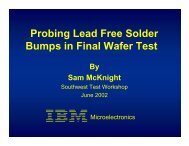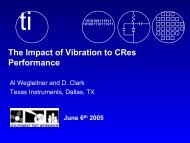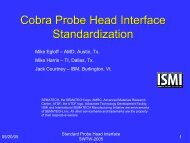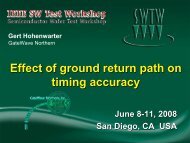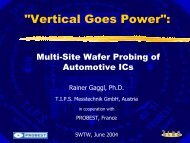Identification, Analysis and Control of High Temperature Influences
Identification, Analysis and Control of High Temperature Influences
Identification, Analysis and Control of High Temperature Influences
You also want an ePaper? Increase the reach of your titles
YUMPU automatically turns print PDFs into web optimized ePapers that Google loves.
June 12 to 15, 2011<br />
San Diego, CA<br />
<strong>Identification</strong>, analysis <strong>and</strong> control<br />
<strong>of</strong> high temperatures on wafer test<br />
probing gprocesses<br />
Marcel Bleyl, Jan Martens<br />
NXP Semiconductors Germany<br />
Darren James<br />
Rudolph Technologies
Overview<br />
Joint Cooperation & Motivation<br />
<strong>Temperature</strong> Influence on Probing<br />
Experimental data<br />
Results & Future Work<br />
June 12 to 15, 2011<br />
IEEE SW Test Workshop 2
Joint Cooperation &<br />
Motivation<br />
<strong>Temperature</strong> Influence on Probing<br />
Experimental data<br />
Results & Future Work<br />
June 12 to 15, 2011<br />
IEEE SW Test Workshop 3
NXP Testcenter Europe<br />
• Engineering gsite for high<br />
performance mixed signal<br />
products, automotive <strong>and</strong><br />
identification business.<br />
• Applications with very high<br />
multisite factors <strong>and</strong> small pad<br />
pitch.<br />
• Capability to collect high temperature probing data<br />
within production like automated environment<br />
June 12 to 15, 2011<br />
IEEE SW Test Workshop 4
NXP Motivation<br />
• <strong>High</strong> temperature probing becoming more challenging due to<br />
increasing requirements (e.g. 200 °C) C), mostly driven by the<br />
automotive market.<br />
• Smaller pad libraries ba es<strong>of</strong> advanced a processes require e higher<br />
accuracy to the probe to pad alignment (PTPA).<br />
• Probing process analysis was made inhouse in the past.<br />
Evaluation <strong>of</strong> external tools was needed.<br />
d<br />
• Review <strong>and</strong> optimization <strong>of</strong> existing NXP production process<br />
settings for soaktimes <strong>and</strong> PTPA<br />
• St<strong>and</strong>ardization <strong>of</strong> probing process analysis needed in NXP.<br />
June 12 to 15, 2011<br />
IEEE SW Test Workshop 5
Rudolph Technologies Motivation<br />
• Validate new wafer sort process capabilities<br />
• Collaborative partnership with industry leader<br />
• Positive feedback for product development<br />
WaferWoRx Process <strong>Analysis</strong><br />
• KGD critical markets<br />
– Automotive<br />
– Medical<br />
– TSV & Stacked packaging<br />
• Rapid data analysis <strong>and</strong> review<br />
– <strong>High</strong> temperature applications<br />
– Low temperature applications<br />
– All probe card technologies<br />
• Multiple data review options<br />
– Normalized single variable<br />
– Vector view<br />
– User selectable<br />
June 12 to 15, 2011<br />
IEEE SW Test Workshop 6
Joint Cooperation & Motivation<br />
<strong>Temperature</strong> Influence on<br />
Probing<br />
Experimental data<br />
Results & Future Work<br />
June 12 to 15, 2011<br />
IEEE SW Test Workshop 7
PTPA stress influence<br />
• Main mechanical stress factors<br />
– Test head docking depending on interface design<br />
–Probe card fixture <strong>and</strong> l<strong>and</strong>ing in probe card changer<br />
– PCB Stiffner fixture<br />
–Probe head fixture (for replaceable heads)<br />
• Main thermal stress factors<br />
– Thermal gradient in probe card<br />
–PCB stiffness<br />
– Thermal expansion <strong>of</strong> head plate lt <strong>and</strong> probe card changer<br />
–Moving chuck continuous stress, no saturation<br />
– Chuck distance (clearance) to probe card<br />
June 12 to 15, 2011<br />
IEEE SW Test Workshop 8
Continuous thermal stress by<br />
• Wafer start up<br />
–Fast heating <strong>of</strong> PCB<br />
moving chuck<br />
– Head plate slow temp. change<br />
• Moving chuck<br />
– Change <strong>of</strong> thermal gradient in PCB<br />
– Depends on size <strong>and</strong> thickness<br />
• Long term status<br />
– Headplate warms up<br />
– Continuous change <strong>of</strong> thermal<br />
gradient in PCB<br />
June 12 to 15, 2011<br />
IEEE SW Test Workshop 9
Solutions to limit thermal stress<br />
• Preventive Probe card solutions<br />
– Probe card construction/materials<br />
• Schaefer et al SWTW2009<br />
• Breinlinger – SWTW2010<br />
– Probe card shielding to reduce heating<br />
• Wegleitner et al – SWTW2006<br />
– Probe card heater to harmonize temperature gradient<br />
• Molinari et al – SWTW2010<br />
• Wegleitner et al – SWTW2006<br />
• Online Process solutions<br />
– Soak times to avoid big movements at wafer start<br />
– Probe to pad realignments to compensate continuous stress by moving<br />
chuck<br />
– Find ideal stepping pattern<br />
June 12 to 15, 2011<br />
IEEE SW Test Workshop 10
Online Realignment ‐ pros & cons<br />
• Manual probe mark inspection <strong>and</strong> realignment by operator (2D)<br />
+ Flexible use, no equipment automation needed<br />
– Difficult use for large probe arrays <strong>and</strong> multiple touchdowns<br />
– Slow, expensive <strong>and</strong> inaccurate if realignment frequency is too high<br />
• Automated probe mark inspection <strong>and</strong> realignment (2D)<br />
+ Faster because <strong>of</strong> 2‐dimensional analysis only<br />
– Not usable for second or further test stages due to multiple probe marks<br />
– Some probe technology/pad technology combinations have invisible probe marks<br />
– No probe height correction.<br />
• Automated needle position inspection <strong>and</strong> realignment (3D)<br />
+ Usable for multiple test stages NXP<br />
+ Direct needle height measurement<br />
– Not fast enough if too many probes inspected<br />
Solution<br />
– Depends on prober <strong>and</strong> camera alignment accuracy (probecard/wafer alignment)<br />
June 12 to 15, 2011<br />
IEEE SW Test Workshop 11
Production data example<br />
Prober needle realignment log data for 12 tested wafers (2,5h/wafer @ 125°C)<br />
Probing time<br />
X correction<br />
Y correction<br />
Wafer to Wafer<br />
PTPA<br />
movements<br />
Z correction<br />
June 12 to 15, 2011<br />
IEEE SW Test Workshop<br />
12
Joint Cooperation & Motivation<br />
<strong>Temperature</strong> Influence on Probing<br />
Experimental data<br />
Results & Future Work<br />
June 12 to 15, 2011<br />
IEEE SW Test Workshop 13
Overview DOE‘s<br />
• In total 6 experiments including 45 wafers with 60<br />
different settings were prepared<br />
• DOE 1 Tool Comparison<br />
– 10 wafers were prepared in order to compare<br />
inhouse solution to WaferWoRx<br />
• DOE 2 Stepping pattern optimization<br />
–5 wafers were used<br />
• DOE 3Realignment Optimization<br />
–17 wafers were analysed with a large temperature<br />
range <strong>and</strong> different realignment/soaktime settings<br />
June 12 to 15, 2011<br />
IEEE SW Test Workshop 14
DOE 1 ‐ Tool Comparison<br />
Comparison <strong>of</strong> WaferwoRx with NXP solution<br />
• 10 wafers were probed with intentionally generated,<br />
typical production probing errors.<br />
– Probe card errors: pitch, role, yaw, etc.<br />
– Prober errors: Scaling, orthogonality, overtravel, etc.<br />
• Rudolph WaferwoRx <strong>and</strong> NXP inhouse inspection<br />
solution scanned all wafers<br />
– All 10 errors identified ed by both machines <strong>and</strong> dteams<br />
–Both machines capable to identify typical production<br />
errors, misalignments <strong>and</strong> maintenance issues<br />
June 12 to 15, 2011<br />
IEEE SW Test Workshop 15
DOE 2 ‐ Stepping pattern optimization<br />
What is the best probing pattern for high temperatures?<br />
• 5 Wafers were probed with different stepping patterns on wafer<br />
– Probing paths created with MultiSiteOptimizer (MSO) by SPA<br />
• St<strong>and</strong>ard me<strong>and</strong>er<br />
• Radial <strong>and</strong> spiral starting in the middle<br />
• Shortest <strong>and</strong> longest probing path<br />
– Probed at 125°C without realignment<br />
– St<strong>and</strong>ard soak time 2min. after direct heating from 30°C to 125°C<br />
• Probing configuration<br />
– Accretech UF3000, Teradyne J750<br />
– Vertical Probecard, 104 beams<br />
• <strong>Analysis</strong> done on WaferwoRx + MS Excel<br />
– Additional analysis with Excel 2007 <strong>and</strong> Pivot Feature<br />
June 12 to 15, 2011<br />
IEEE SW Test Workshop 16
DOE 2 ‐ MSO stepping<br />
pattern description<br />
Me<strong>and</strong>er<br />
Radial<br />
Longest Way<br />
Spiral<br />
Shortest Way<br />
June 12 to 15, 2011<br />
IEEE SW Test Workshop 17
DOE 2 ‐ WaferWoRx<br />
Y Scrub Position<br />
Me<strong>and</strong>er<br />
Radial<br />
Longest Way<br />
What is<br />
best?<br />
Spiral<br />
+ 5µm<br />
Shortest Way<br />
- 5µm<br />
June 12 to 15, 2011<br />
IEEE SW Test Workshop 18
DOE 2 ‐ WaferWoRx<br />
Vector View<br />
Me<strong>and</strong>er<br />
Radial<br />
Longest Way<br />
What is<br />
best?<br />
Spiral<br />
+ 5µm<br />
Shortest Way<br />
- 5µm<br />
June 12 to 15, 2011<br />
IEEE SW Test Workshop 19
DOE 2 ‐ Conclusion from<br />
WaferWoRx view<br />
• Stepping Pattern recognized in plots<br />
• Estimation possible on favorable pattern<br />
How do I…<br />
• get the probing time aligned with my analysis data?<br />
• compare wafer results in one graph?<br />
• get more flexibility to experiment with probemark data?<br />
Additional analysis with Excel 2007 <strong>and</strong> Pivot Feature<br />
June 12 to 15, 2011<br />
IEEE SW Test Workshop 20
DOE 2 ‐ Total probe area<br />
Comparison <strong>of</strong> stepping patterns regarding probe area<br />
Me<strong>and</strong>er Radial Longest Way<br />
9µm<br />
6µm<br />
10µm<br />
12µm<br />
8µm<br />
10µm<br />
Spiral<br />
Probemarks<br />
Shortest Way<br />
12µm<br />
6µ µm<br />
Total Probe area<br />
80% Probe area<br />
11µ µm<br />
one dot = av. <strong>of</strong> touchdown<br />
8µm<br />
June 12 to 15, 2011<br />
IEEE SW Test Workshop 21
DOE 2 ‐ PTPA development<br />
Development <strong>of</strong> probe mark position resp. probing time<br />
Me<strong>and</strong>er<br />
Radial<br />
Longest Way<br />
Spiral<br />
Time to PTPA<br />
Position<br />
Videos, very<br />
powerful!<br />
Shortest Way<br />
June 12 to 15, 2011<br />
IEEE SW Test Workshop 22
DOE 2 ‐ X/Y Position change<br />
X/Y Postion [µm] over time (~1hour) for different stepping pattern<br />
Me<strong>and</strong>er<br />
Radial<br />
Longest Way<br />
Useful chart type<br />
for Realignment<br />
definition<br />
Spiral<br />
Probing time<br />
Mean Y Scrub Position<br />
Shortest Way<br />
Mean X Scrub Position<br />
June 12 to 15, 2011<br />
IEEE SW Test Workshop 23
DOE 2 –Comparison Y Position<br />
Y Position [µm] over time (~1hour) for different stepping pattern<br />
Shortest Way<br />
Radial<br />
Spiral<br />
Longest way<br />
Me<strong>and</strong>er<br />
Probing time<br />
June 12 to 15, 2011<br />
IEEE SW Test Workshop<br />
24
DOE 2 –Comparison X Position<br />
X Postion [µm] over time (~1hour) for different stepping pattern<br />
Shortest Way<br />
Radial<br />
Spiral<br />
Longest way<br />
Me<strong>and</strong>er<br />
Probing time<br />
June 12 to 15, 2011<br />
IEEE SW Test Workshop<br />
25
DOE 2 ‐ Results<br />
What is the best probing pattern for high temperatures?<br />
• Significant probe to pad movement at 125°C<br />
–All pattern need minimum one realignment<br />
– Smallest movements with radial/spiral pattern<br />
– Shortest <strong>and</strong> longest way unexpected large movements<br />
–Longest way expensive –very large index times<br />
• WaferwoRx improvement proposals<br />
–Time resolution 2D charts<br />
– Data comparison <strong>of</strong> several wafers in one graph<br />
–Time resolution scatter plots<br />
– Video scatter plots<br />
June 12 to 15, 2011<br />
IEEE SW Test Workshop 26
DOE 3 – Realignment Optimization<br />
What are the best realignment settings for extreme temperatures?<br />
• 17 Wafers were probed with different<br />
temperatures/realignment/soaktime settings<br />
–Cold, ambient, hot (‐60°C, 30°C, 125°C, 175°C, 200°C)<br />
– Me<strong>and</strong>er <strong>and</strong> Radial probing pattern for high temperatures<br />
–Soaktime 2min <strong>and</strong> NXP std. realignment<br />
• Probing configuration<br />
– Accretech UF3000, Teradyne J750<br />
– Vertical lProbecard, 104 beams<br />
• <strong>Analysis</strong> done on WaferwoRx + MS Excel<br />
– Additional analysis with Excel 2007 <strong>and</strong> Pivot Feature<br />
June 12 to 15, 2011<br />
IEEE SW Test Workshop 27
DOE 3 ‐ WaferWoRx<br />
Y Scrub Position<br />
-60°C 30°C 125°C<br />
How do I<br />
define<br />
realignment<br />
timings?<br />
+ 5µm<br />
175°C 200°C<br />
- 5µm<br />
June 12 to 15, 2011<br />
IEEE SW Test Workshop 28
DOE 3 ‐ WaferWoRx<br />
Vector View<br />
-60°C 30°C 125°C<br />
How do I<br />
define<br />
realignment<br />
timings?<br />
+ 5µm<br />
175°C 200°C<br />
- 5µm<br />
June 12 to 15, 2011<br />
IEEE SW Test Workshop 29
DOE 3 ‐ Conclusion from<br />
WaferWoRx view<br />
• Expected temperature difference recognized in plots<br />
• Realignment positions visible<br />
• Estimation <strong>of</strong> optimized realignment settings difficult<br />
How do I…<br />
• get the probing time aligned with my analysis data?<br />
• include prober needle realigment data?<br />
• get more flexibility to experiment with data?<br />
Additional analysis with Excel 2007 <strong>and</strong> Pivot Feature<br />
June 12 to 15, 2011<br />
IEEE SW Test Workshop 30
200°C Probemark Distribution<br />
Y Pad Dimension n [µm]<br />
Can we see<br />
realignments?<br />
X Pad Dimension [µm]<br />
one dot = av. <strong>of</strong> touchdown<br />
June 12 to 15, 2011<br />
IEEE SW Test Workshop 31
200°C Probemark Distribution<br />
Development <strong>of</strong> the probe position in time<br />
Y Pad Dimension n [µm]<br />
We’re<br />
getting<br />
there…<br />
X Pad Dimension [µm]<br />
June 12 to 15, 2011<br />
IEEE SW Test Workshop 32
200°C Probemark Distribution<br />
Probemarks grouped in the realignment phases using Prober log data<br />
Yes we<br />
can!<br />
Y Pad Dimensio on [µm]<br />
Probemark<br />
position drift<br />
Until 1st realignment<br />
After 1st realignment<br />
After 2nd realignment<br />
After 3rd realignment<br />
X Pad Dimension [µm]<br />
one dot = av. <strong>of</strong> touchdown<br />
June 12 to 15, 2011<br />
IEEE SW Test Workshop 33
200°C Probemark Distribution<br />
Significance <strong>of</strong> realignment visible by comparing total probe area<br />
Realignment<br />
Probemark<br />
area is<br />
shrunk<br />
by factor 2<br />
20 0µm<br />
17µm<br />
Recalculation<br />
without Realignment<br />
37µm<br />
22µm<br />
one dot = av. <strong>of</strong> touchdown<br />
June 12 to 15, 2011<br />
IEEE SW Test Workshop 34
DOE 3 ‐ X/Y Position change<br />
X/Y Postion [µm] over time (~1hour) for different temperatures<br />
-60°C 30°C 125°C<br />
Probing time<br />
175°C 200°C<br />
Mean Y Scrub Position<br />
Mean X Scrub Position<br />
June 12 to 15, 2011<br />
IEEE SW Test Workshop 35
DOE 3 –Comparison Y Position<br />
Y Postion [µm] over time (~1hour) for different temperatures<br />
200°C<br />
175°C<br />
125°C<br />
30°C<br />
-60°C<br />
Probing time<br />
June 12 to 15, 2011<br />
IEEE SW Test Workshop<br />
36
DOE 3 –Comparison X Position<br />
X Postion [µm] over time (~1hour) for different temperatures<br />
200°C<br />
175°C<br />
125°C<br />
30°C<br />
-60°C<br />
Probing time<br />
June 12 to 15, 2011<br />
IEEE SW Test Workshop<br />
37
DOE 3 ‐ Results<br />
What are the best realignment settings for extreme temperatures?<br />
• All hot <strong>and</strong> cold probing temperatures show significant<br />
probe to pad movements<br />
– <strong>Temperature</strong> distance to ambient is main driver<br />
– 200°C with ihbiggest probe to pad deviations<br />
i<br />
– Realignments defined depending on probing temperature<br />
• WaferWoRx improvement proposals<br />
–Probe log data <strong>and</strong> map data input interface<br />
– Realignment identification<br />
–Raw data transformation <strong>and</strong> modification<br />
June 12 to 15, 2011<br />
IEEE SW Test Workshop 38
Joint Cooperation & Motivation<br />
<strong>Temperature</strong> Influence on Probing<br />
Experimental data<br />
Results & Future Work<br />
June 12 to 15, 2011<br />
IEEE SW Test Workshop 39
Results<br />
• Successful process optimization<br />
– Different stepping patterns evaluated<br />
–Soak time <strong>and</strong> realignment settings optimized<br />
–Up to 200°C tested <strong>and</strong> recipes defined<br />
• Evaluation <strong>of</strong> WaferWoRx to in house tools done. Both<br />
are technically comparable.<br />
–All st<strong>and</strong>ard errors were succesfully identified.<br />
• Recommendations developed to improve WaferWoRx<br />
models <strong>and</strong> graphical user interface<br />
– <strong>Temperature</strong> analysis needs time resolution GUI<br />
–Prober log data <strong>and</strong> map data input interface<br />
–Raw data transformation <strong>and</strong> modification needed<br />
June 12 to 15, 2011<br />
IEEE SW Test Workshop 40
Future Work<br />
• Analyze <strong>and</strong> underst<strong>and</strong> differences <strong>of</strong> different<br />
hardware combinations<br />
• Improve test tcell hardware performance to<br />
reduce number <strong>of</strong> needed realignments<br />
• <strong>Analysis</strong> results <strong>and</strong> method to be roled out in<br />
NXP<br />
June 12 to 15, 2011<br />
IEEE SW Test Workshop 41
Acknowledgements<br />
– Rudolph Technologies<br />
•Darren James<br />
–JP Kummer<br />
•Rex S<strong>and</strong>bach<br />
•Sam Waggoner<br />
– Accretech<br />
•Maik Ehlen<br />
– NXP Semiconductors<br />
•Thomas Dabelstein<br />
•Jens Däbritz<br />
• Swen Mohr<br />
Providing NXP with<br />
oppurtunity to<br />
evaluate WaferWoRx<br />
<strong>and</strong> optimize<br />
performance.<br />
Working on<br />
preparation, data<br />
acquisition <strong>and</strong><br />
analysis.<br />
June 12 to 15, 2011<br />
IEEE SW Test Workshop 42
Questions?<br />
June 12 to 15, 2011<br />
IEEE SW Test Workshop 43



